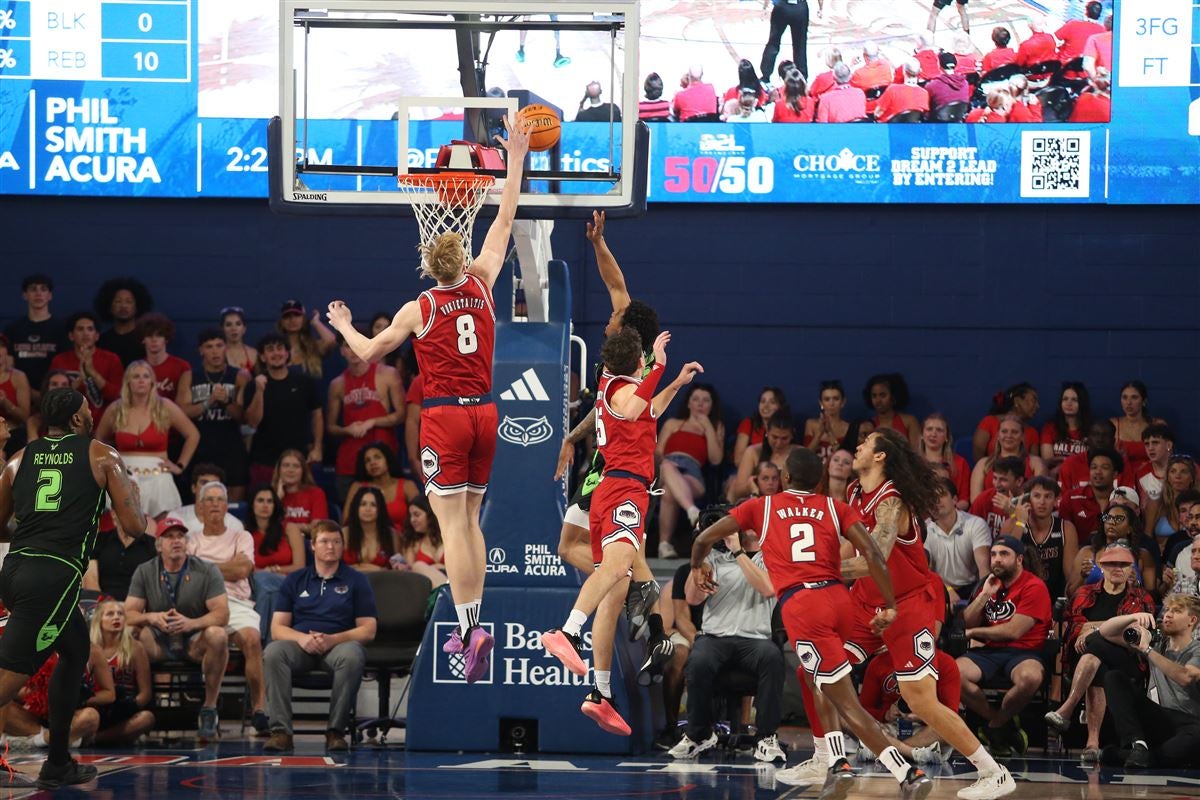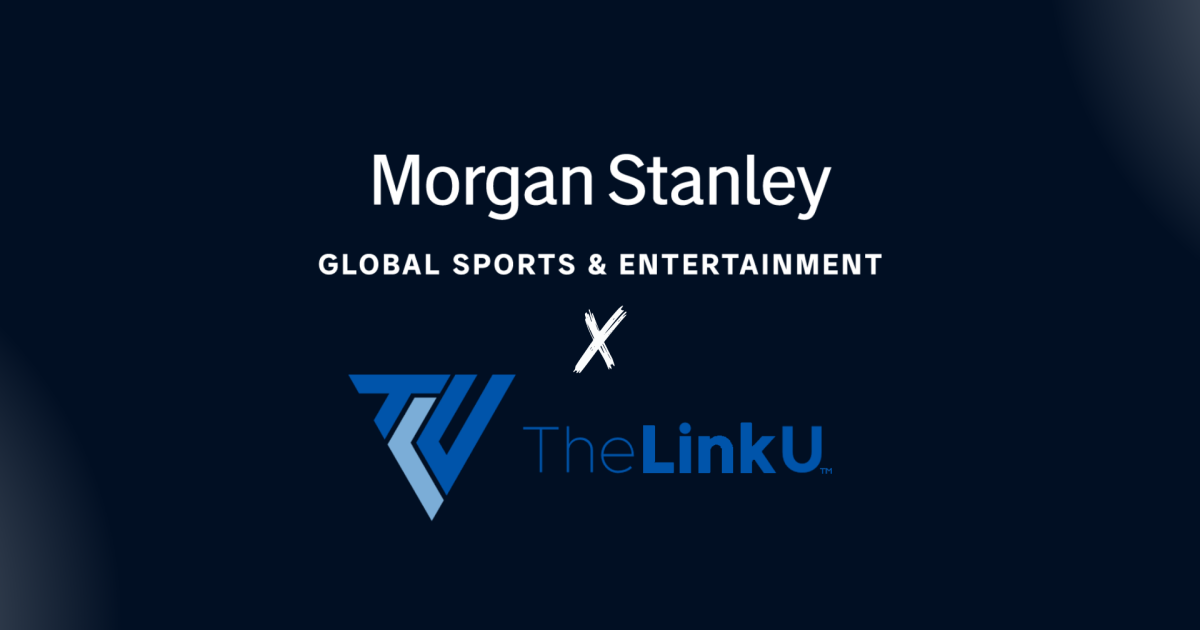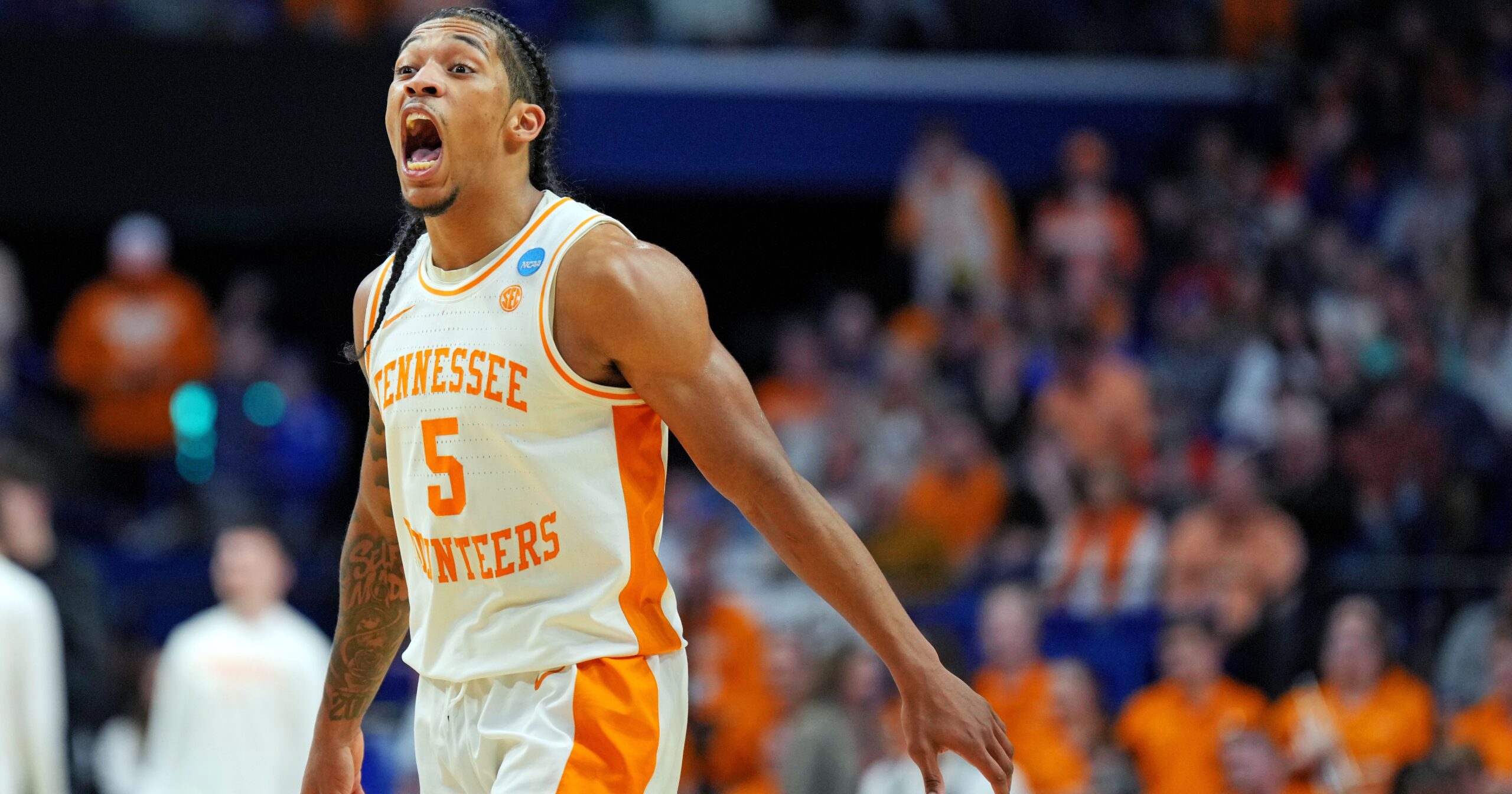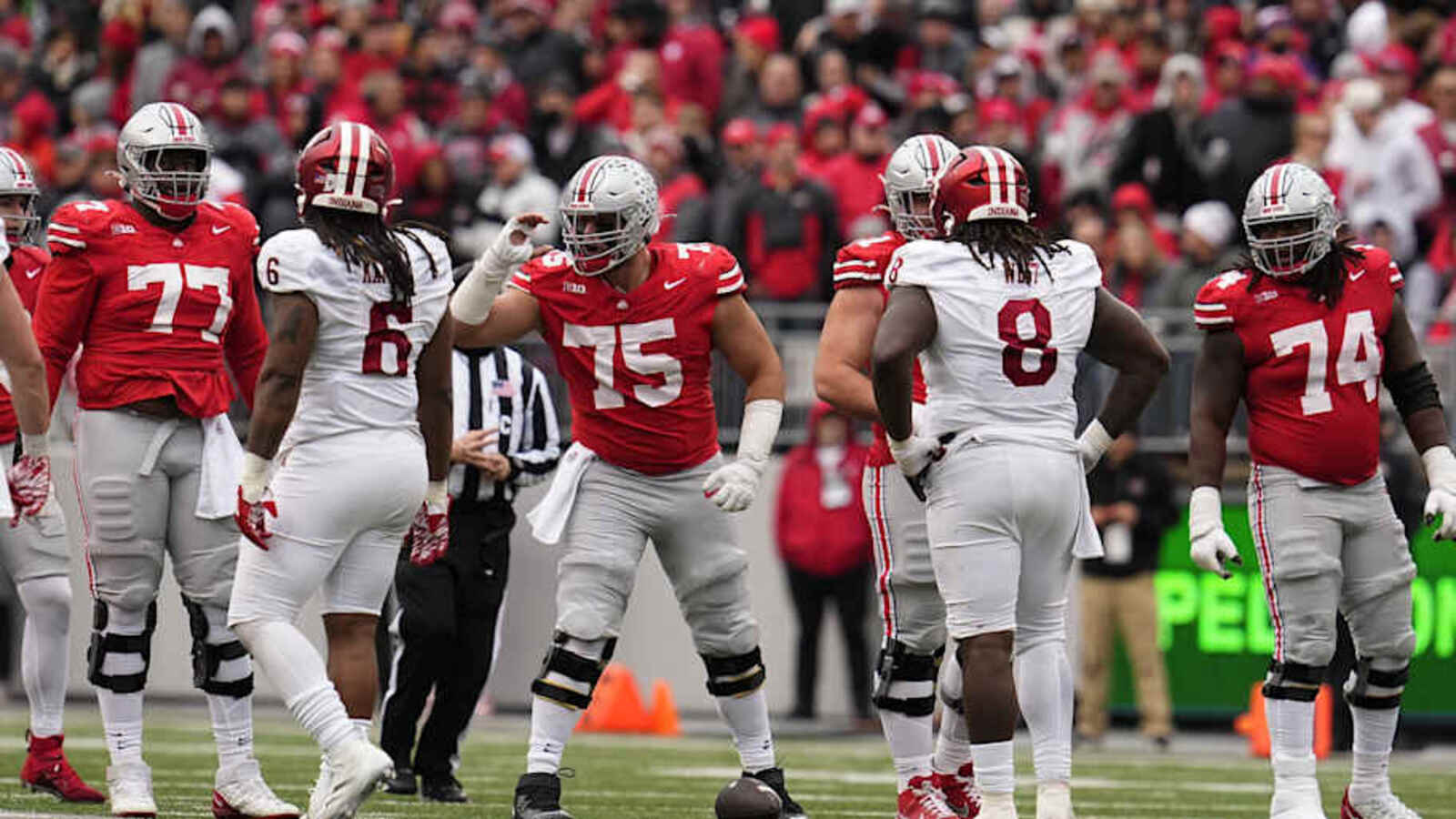NIL
FAU's Baba Miller commits to Cincinnati from NCAA Transfer Portal
Wesley Hale | Imagn Images FAU’sBaba Miller has committed to Cincinnati from the NCAA Transfer Portal. That comes per reporting by ESPN’s Jonathan Givony this afternoon according to his representation. Miller has also since confirmed that news himself with a post on social media. He shared his farewell graphic to the Owls earlier today before […]


FAU’sBaba Miller has committed to Cincinnati from the NCAA Transfer Portal. That comes per reporting by ESPN’s Jonathan Givony this afternoon according to his representation.
Miller has also since confirmed that news himself with a post on social media. He shared his farewell graphic to the Owls earlier today before posting his commitment graphic for the Bearcats.
Miller has played in Florida throughout his three-year collegiate career with this past season spent at Florida Atlantic after the two prior at Florida State. He has averaged 8.5 points (47.1% FG), 5.5 rebounds, 1.8 assists, and 1.2 blocks per game, in 82 games played with 68 starts, for the Owls and Seminoles. He had a career-best season this past year as a junior at 11.3 points (48.6% FG), 7.0 rebounds, 2.7 assists, and 1.7 blocks for FAU, which earned him a selection as Second Team All-AAC.
Miller, a native of Mallorca, came from overseas as a Top-200 recruit and a three-star in the 2022 cycle. He also rated just outside the Top-30 at power forward in the class. That’s according to the On3 Industry Ranking, a weighted average that utilizes all four major recruiting media companies.
Now, in his second transfer in as many offseasons, Miller was one of the top players still available in the portal. He, per the latest update to On3’s Industry Ranking of 2025’s Top Transfer Portal Players, ranked at No. 106 and as a Top-20 PF.
This report will be updated further
To keep up with the latest players on the move, check out On3’s Transfer Portal wire.
The On3 Transfer Portal Instagram account and Twitter account are excellent resources to stay up to date with the latest moves.
The post FAU’s Baba Miller commits to Cincinnati from NCAA Transfer Portal appeared first on On3.
NIL
Could an Adidas NIL deal shift the recruitment of the Nation’s Top WR recruit?
As the start of the Summer arrives one of the biggest recruiting periods of the year begins as official visits get underway. One of the biggest storylines in a busy recruiting period is where the Nation’s top ranked Wide Receiver Tristen Keys will end up playing College Football. Keys is currently committed to LSU after […]

As the start of the Summer arrives one of the biggest recruiting periods of the year begins as official visits get underway. One of the biggest storylines in a busy recruiting period is where the Nation’s top ranked Wide Receiver Tristen Keys will end up playing College Football. Keys is currently committed to LSU after announcing his decision this Spring but, this recruitment may not be over.
This past weekend, Tristen Keys took an official visit to Miami which was one of the presumed front runners before he committed. On deck for Keys are official visits to Alabama, Auburn, Texas A&M, Tennessee, and LSU which could indicate this recruitment still could take some turns.
On Wednesday, Keys’ recruitment may have taken an interesting turn as he signed an NIL deal with Adidas.
Keys picking to sign an NIL deal with Adidas is interesting for several reasons but, mainly the fact that LSU is a Nike school. This could become an interesting development as Keys wouldn’t be able to wear Adidas on the field at LSU which brings about questions. The same situation just unfolded with Cooper Flagg who was signed with New Balance but, couldn’t wear their gear on the court.
On the other hand, Keys’ situation differs from Flagg’s as everyone knew Cooper Flagg was a one and done while Tristen Keys will spend at least 3 years in College Football. New Balance knew they were only waiting one year and getting an early jump on landing Cooper Flagg.
As Keys’ now is signed with Adidas is it possible that he ends up signing with an Adidas school? Among the teams he’ll visit, Adidas is the partner of Miami, Texas A&M, and Tennessee is rumored to be considering returning to Adidas once its Nike contract expires.
In the end, the only parties that know the ins and outs of this deal are Tristen Keys and his team as well as Adidas. Keys could certainly still pick and sign with a Nike school but, Adidas would most likely prefer their latest signee is in their apparel.
NIL
Softball player Cayden Baker owns The Place Nutrition in Halls
Al Lesar | Shopper News Subscribe to Knox News: Local journalists covering local stories Knox News journalists cover the important moments in Knoxville. Support local journalism by subscribing. Cayden Baker is a social media intern for Tennessee Mojo, making regular posts and announcements, and giving top players advice on recruiting and name, image and likeness […]

Subscribe to Knox News: Local journalists covering local stories
Knox News journalists cover the important moments in Knoxville. Support local journalism by subscribing.
- Cayden Baker is a social media intern for Tennessee Mojo, making regular posts and announcements, and giving top players advice on recruiting and name, image and likeness financial deals.
- The former Powell High softball player also is a UT student, owns a business and works part time as a receptionist.
As if owning a business wasn’t enough … or working a second job … or having a time-consuming internship … or carrying a full class load at the University of Tennessee at Knoxville … Cayden Baker’s days — and nights — are full, even without the game of softball that she once loved so much.
Baker, a 2021 Powell High School graduate, had a great softball career at Powell and with the Tennessee Mojo elite summer travel team. She was good enough to get recruited by Texas A&M.
She started 43 games and played in all 52 as a freshman infielder. She hit .261 and didn’t make an error.
However, after a coaching change, the new coach cut four players and Baker was one of them.
She landed at Georgia Tech. Just before the start of the spring season, Baker’s family had an emergency. When the Yellow Jackets’ coach refused to help her through the crisis, she left school and came home.
The last two years, with softball in the rear-view mirror, she has been working on finishing her degree in public relations at UT.
“I would not change anything in my high school or travel (softball) careers,” Baker said. “I had never played for a woman coach (as there were at A&M and Georgia Tech) before. That was hard to get used to. There were way more emotions involved than I had ever seen.”
Knowing customers is essential
Though she has a 3.7 GPA and will graduate at the end of the summer, Baker didn’t come back home to sit back and relax. Her mother, DeLinda, owns Emory Station Nutrition and The Baby Station in Powell. Since they already knew the business, buying Halls Nutrition (which is now The Place Nutrition, 6663 Maynardville Pike in Halls) in December 2022 made sense.
“People think owning a business is a luxury,” Baker said. “It’s a lot of work. You have to prioritize it, keep up with the trends. Customer service is so important. If you don’t know a customer’s name and past order, you’re doing something wrong.”
The Place Nutrition specializes in energy drinks, protein shakes and teas.
Baker, who relies on a quality manager to run the store, works at The Place Nutrition on Tuesdays and Thursdays. On Mondays and Wednesdays she is a receptionist at a beauty salon. Weekends are also consumed with work of some sort.
Decision time is coming
Staying in touch with softball by way of a social media internship for Tennessee Mojo scratches her itch for the game. Besides doing regular posts and announcements, she helps top players with advice on recruiting and name, image and likeness financial deals.
“Most of the NIL deals for softball come in the form of equipment or merchandise,” Baker said. “Only a few of the top, top players are getting big money. It’s not like football and (men’s and women’s) basketball.”
By the end of the summer, Baker will have a decision to make: Get more involved with the travel softball team, or dedicate a lot more time to The Place Nutrition.
“I’ve learned a lot about time management by doing all this,” she said. “I’ve learned to hold myself accountable for whatever needs to get done.”
NIL
Morgan Stanley, NIL firm team up on NCAA athletes' financial education
Rising pay for college athletes brings more planning risks and opportunities, prompting a new collaboration that will send Morgan Stanley financial advisors to campuses around the country. Morgan Stanley Global Sports & Entertainment and “name, image and likeness” technology and management firm TheLinkU are teaming up with National Collegiate Athletic Association conferences and university athletic […]



Rising pay for college athletes brings more planning risks and opportunities, prompting a new collaboration that will send Morgan Stanley financial advisors to campuses around the country.
Morgan Stanley Global Sports & Entertainment and “name, image and likeness” technology and management firm
The program is launching as the compensation for athletes ranging from thousands of dollars to several million is leading to more efforts
The involvement of Morgan Stanley was “really important for me and for the athletes, because it gives instant credibility,” since both the wealth management company’s unit and TheLinkU aim to give the players “the tools to be successful,” said founder Austin Elrod. His firm works with athletes, athletic departments and colleges to maximize their NIL through identification of opportunities, contract management technology and other services.
The education could turn into client relationships for the Morgan Stanley advisors and executives coaching the students if “the athletes determine that they would like to take the next steps,” Elrod said in an interview.
“It was important for me to make sure that we brought in the best of the best,” he said. “Having that brand power, that protection layer associated with this was really important. I knew that would increase the participation of the student athletes.”
READ MORE:
Big pay, big challenges
NIL payments have created something
At the same time, the athletes are fielding interest from so-called agents or NIL firms demanding much higher commissions from them than those received by agents representing professional sports players, he noted. Brown, a former NCAA football player who became an advisor, speaks with college athletes and coaches them on financial topics on a pro bono basis. He has also launched
An environment of growing overtures to the players from licensed experts and potential bad actors alike “forces the younger student-athlete to do their due diligence, sooner rather than later,” Brown said. And they have valid concerns about what will happen if they, like most NCAA athletes, can’t play their sport professionally, he added.
“If the end result is that the student athlete doesn’t make it to the next level, are you going to stick it out with that former student athlete as a client?” Brown said. “I don’t know how much some of this stuff is going to be sustainable.”
READ MORE:
A huge but uncertain potential settlement
To that point, some aspects of NIL could see dramatic shifts in the rules for the compensation based on the pending settlement in the
As many as 390,000 current and former athletes could get back payments amounting to $2.77 billion, and every Division I school could then share up to $20.5 million in media revenue with athletes from their colleges, starting on July 1. Any future NIL deals over $600 would need approval from a third-party clearinghouse deciding whether the contracts represent the “fair market value.”
But the agreement between the parties hasn’t received final approval from the judge in the case. And legislative action by Congress or an executive order from the White House could alter the guidelines further.
In that murky landscape, the more than 300 Morgan Stanley advisors in the sports and entertainment unit could offer the athletes some valuable financial education and advice.
“College athletics has seen unprecedented change over the past few years,” Sandra Richards, head of the Morgan Stanley unit, said in a statement. “The need for financial education and guidance has become increasingly critical for college athletes, parents, coaches, and other stakeholders.”
READ MORE:
An opportunity and a need
And that will be especially true after the terms of the House settlement will “allow billions of dollars to flow to student athletes from institutions,” said Elrod. Currently, the firms are planning advisors’ trips to speak with teams from three conferences — the Big 12, the Mid-American Conference (MAC) and Conference-USA — with more possible agreements on the way.
Regardless of the complex negotiations ongoing over possible limits on NCAA rosters or future laws, advisors should educate themselves about the ramifications of the settlement and how working with college athletes is different from planning for pro sports players, he said.
“If you do that, you’re going to see all the opportunities that are coming from this space and the need,” Elrod said. “The more good and smart, savvy people we have in this space, the better.”
NIL
U.S. Department of Justice, NCAA to Zakai Zeigler: Get a job!
Zakai Zeigler filed a lawsuit against the NCAA regarding his eligibility back in May, pushing to play in 2025-26 after alleging that the rule permitting just four seasons of competition in a five-year window is “in an unlawful restraint of trade under federal and state antitrust laws.” In the same lawsuit, he alleges his NIL […]

Zakai Zeigler filed a lawsuit against the NCAA regarding his eligibility back in May, pushing to play in 2025-26 after alleging that the rule permitting just four seasons of competition in a five-year window is “in an unlawful restraint of trade under federal and state antitrust laws.” In the same lawsuit, he alleges his NIL valuation for the upcoming season would fall between $2 million and $4 million based on his value as an “upperclassman with a proven performance record and high visibility, especially in a high-profile conference like the SEC.”
The NCAA’s response? Get a job — one that doesn’t include playing basketball for the Tennessee Volunteers (or anywhere in the collegiate ranks, for that matter). They denied Zeigler’s motion on Monday, making it clear the lawsuit only hurts future student-athletes, particularly incoming freshmen in need of those roster spots the post-graduate players out of eligibility are trying to take.
Though Zeigler says a fifth year of eligibility would allow him to cash out on one final lucrative NIL deal in college while developing as a potential pro, the NCAA said if the Tennessee star “had a viable path to the NBA, given his resume, he would already be a viable prospect. After all, NBA scouts would have seen him play in 138 collegiate contests. … There is no evidence that one more season of participation in college basketball is necessary (for Zeigler to play professionally)” considering he’s already met the age and experience requirements to enter the draft, but passed multiple times in favor of a degree.
“While Plaintiff focuses only on what that means for himself, he does so to the detriment of the entering student-athletes who dream of being the next Zakai Zeigler,” the NCAA said. “… College athletics is a means to a better end for student-athletes — not the end itself.”
Ouch.
It’s not just the NCAA defending itself in the lawsuit, either, which will be heard by a U.S. District Judge on Friday. The U.S. Department of Justice has also decided to voice its opinion on Zeigler’s lawsuit — a first in eligibility cases. Though it didn’t explicitly take a side, the DOJ did ask the court to apply a “flexible rule-of-reason approach” when hearing the case while considering the NCAA v. Alston ruling in 2021 regarding the violation of antitrust laws.
In short, the court can decide how it chooses to decide, but the eligibility rules help maintain fairness and academic standards and following those rules can prevent schools from gaining unfair athletic advantages. It’s a rule that preserves academic integrity and distinguishes them from professional sports.
“Eligibility rules — like the scholarship rules upheld in the Alston litigation — not only can enhance consumer demand—potentially leading to greater compensation—but also can enhance quality in the labor market by preserving ‘the distinction between college sports and professional sports,’” the DOJ wrote. “… We ask this Court to take into account the legal principles laid out above in applying the rule of reason. Whether and to what extent specific anticompetitive effects and procompetitive benefits arise from the Four Seasons Rule in the student-athlete labor market are factual questions to be answered based on the record at the upcoming hearing, and the United States takes no position on those facts.
“We urge the court, however, to consider how the rule may benefit competition in the relevant labor market, including by potentially enhancing the quality of the student-athlete experience.”
In other words, you are not special, Zakai Zeigler. You played in 138 games across four seasons, averaging 29.3 minutes per contest en route to all-time status at Tennessee. Owning the school record for assists (747) and steals (251) while sitting in fifth among games and minutes played, No. 18 in scoring at 1,556 career points, it’s time to move on.
Get a job. It’s time. The NCAA already thought so, and now, the U.S. Department of Justice agrees.
NIL
NiJaree Canady Makes History with Record-Breaking $1M NIL Deal at Texas Tech – BlackPressUSA
By Dr. Benjamin F. Chavis, Jr.President and CEO, National Newspaper Publishers Association President Donald Trump’s housing policy is shaping up to be both an economic and humanitarian disaster, and if leaders across the political spectrum don’t act soon, the damage may be irreversible. To be clear, housing policy was already broken long before Trump returned […]

By Dr. Benjamin F. Chavis, Jr.
President and CEO, National Newspaper Publishers Association
President Donald Trump’s housing policy is shaping up to be both an economic and humanitarian disaster, and if leaders across the political spectrum don’t act soon, the damage may be irreversible.
To be clear, housing policy was already broken long before Trump returned to office. But instead of tackling the root causes — like the chronic shortage of Section 8 vouchers and affordable units — some policymakers chose to blame tools like rent-pricing software, which simply reflect the market’s conditions.
Rather than confront the real barriers to affordability, politicians have chosen to target the messenger. That never made sense, and it still doesn’t — a point that Democratic Governor Jared Polis made clear last week by vetoing a bill to ban such technology. If we want lower rents, we don’t need to ban software that reports current prices. We need to build enough housing so the data reflects abundance, not scarcity.
Unfortunately, President Trump has not gotten this memo, and he is making our broken housing system worse. He has already driven up lumber prices with protectionist trade wars and targeted immigrant communities who make up a vital part of the construction workforce. Now, the president is laying the groundwork for another housing crisis that could rival 2008.
In late May, Trump announced he is “giving very serious consideration” to taking Fannie Mae and Freddie Mac public again. These government-backed mortgage giants were central players in the last financial collapse. Under pressure to expand homeownership without oversight, they helped inflate the subprime mortgage bubble. Ten million Americans lost their homes. The institutions got bailed out. Families didn’t.
To prevent that kind of disaster from recurring, the government placed both firms under conservatorship. Releasing them now would create the same reckless incentives that crashed the global economy, and it would benefit deep-pocketed investors just in time for the 2026 elections. When the next economic crash comes, everyday Americans, and especially Americans in underserved communities, will be the ones paying the price.
And it doesn’t stop there. Trump’s proposed budget would cut federal rental assistance by about 40% at a time when nearly half of renters are spending more than a third of their income on housing. “We would see, I think, homelessness escalate in a way that has been really unprecedented,” warned Kim Johnson of the National Low Income Housing Coalition.
Remaining funds would be handed to states as “block grants,” echoing past efforts to gut safety net programs through decentralization and attrition. This is not a serious answer to the housing crisis. It’s an ideological move that risks deepening inequality and instability that will result in a type of “housing apartheid.”
Policymakers from both parties should reject this approach and unite around a new vision: one that builds. Writers Ezra Klein and Derek Thompson call this the “abundance agenda.” In their book Abundance, they challenge local, state, and federal leaders to confront the self-imposed zoning restrictions and regulatory delays that have made it almost impossible to build enough housing.
“You cannot be the party of working families when the places you govern are places working families can no longer afford to live,” Klein wrote. That means reforming exclusionary zoning, streamlining permitting, and shifting the political culture that demonizes developers while ignoring demand. It means prioritizing supply, not just subsidies.
Because if we don’t solve the housing crisis ourselves, voters will turn to anyone who claims they will, even if the solutions are fake or destructive. The values are already there. What we need now is strategy and action. Increasing housing affordability and availability isn’t just good policy. It’s the only way to keep working Americans housed, the economy stable, and America’s future secure and inclusive.
NIL
Can Collective Bargaining Save College Football From Itself in the NIL Era?
The House v. NCAA settlement has the state of college sports in a standstill as schools try to prepare for a murky future of paying players directly for NIL. With the college football season beginning just months after the expected July 1 date, it’s been a chaotic nightmare of an offseason. There’s not even a […]

The House v. NCAA settlement has the state of college sports in a standstill as schools try to prepare for a murky future of paying players directly for NIL.
With the college football season beginning just months after the expected July 1 date, it’s been a chaotic nightmare of an offseason.
There’s not even a guarantee the settlement will be approved.
The worst part is that the players at the center of the issue weren’t consulted and don’t know what the future holds.
In the absence of that voice, the need for collective bargaining and a players union grows more critical by the day.
Jim Cavale, founder of the players association for college athletes, Athletes.org, spoke exclusively with NIL Daily On SI about the need for a sustainable solution in the form of collective bargaining.
Can Collective Bargaining Save College Football in the NIL Era?
Name, image, and likeness entered college sports as the result of a pivotal lawsuit filed by former UCLA Bruins basketball player Ed O’Bannon.
College sports have since been shaped by litigation, and is that truly the path it should continue to follow? Cavale doesn’t believe so.
“The only sustainable solution for college athletics to have rules that can be enforced without litigation is collective bargaining,” Cavale explained.
Before launching Athletes.org with former NFL player Brandon Copeland, Cavale founded INFLCR in 2017, which helped support athletes on social media to build their brand.
They were acquired by Teamworks, and Cavale stayed on as CEO as they built payment and reporting software for clients once NIL began.
Cavale observed that within the more than $300 million in transactions, most of the funds originated from donors who funneled money through collectives, essentially creating a pay-for-play model.
As court cases continued to be filed against the NCAA, Cavale saw the problems in an unstructured environment operating under the guise of NIL when it was really pay-for-play and sought to found Athletes.org.
To date, there are a record 4,700 members in the players association, making it the largest in America. Their focus has been on Power Four football and basketball, of which there are 2,300.
That’s where Cavale anticipates collective bargaining taking center stage first, but the reason he expects that is because of foreseen issues with an incomplete solution in the House settlement.
“We need a set of rules that can be enforced without litigation. We need them in all realms: transfer portal, free agency, compensation, health and safety, et cetera. The only way to do that is through collective bargaining.”
Collective bargaining would also give athletes a voice in this process they really haven’t been included in, despite the plaintiffs representing less than 0.1% of all athletes, all of whom are members of the players association.
“Unfortunately, not only has the greater group of college athletes that are going to be impacted [by House] not been included in that negotiation, but no athletes have been educated on anything pertaining to the settlement,” Cavale said. “The schools have said, We’re going to tell our athletes how it’s all going to work once it gets approved. There are tens of thousands of college athletes that are trying to piece together what this new reality is going to look like through media reports, not direct education from their schools.”
Cavale also pointed out that the compensation provided by schools does not truly qualify as NIL deals. These agreements are a form of pay-for-play. However, the contracts will pertain to NIL publicity rights.
Athletes may sign deals that limit their ability to use their likeness for outside endorsement deals because they’re disguised from their true purposes: their performance on the field.
“Leave real NIL endorsement opportunities open to those athletes, should they have the value, to go command those deals,” Cavale said. “Instead of trying to disguise these deals in a way where you now own their rights to do endorsements or can block them from doing certain endorsements because those brands might conflict with the brand sponsors of your school. That’s going to be a mess. There’s a real crux with how these contracts are being structured that will create a flurry of lawsuits.”
That void in education has created an opportunity for Cavale and his team, as their app educates their members on the topics of roster limits, how money will be dispersed, and why football is commanding a higher amount of $20 million.
The athletes also benefit from pro bono partnerships with law firms, accounting firms, mental health, and more as part of the free membership. Ultimately, they just want to know what the settlement means.
-

 College Sports2 weeks ago
College Sports2 weeks agoPortal Update – Basketball and Gymnastics Take Hits
-

 College Sports2 weeks ago
College Sports2 weeks agoPortal Update – Basketball and Gymnastics Take Hits
-

 Professional Sports2 weeks ago
Professional Sports2 weeks agoJon Jones answers UFC retirement speculation as fans accuse champion of 'holding the belt …
-

 NIL1 week ago
NIL1 week ago2025 NCAA Softball Tournament Bracket: Women’s College World Series bracket, schedule set
-

 Health2 weeks ago
Health2 weeks agoBYU women's basketball guard injures ACL twice
-

 Youtube2 weeks ago
Youtube2 weeks agoXavier Legette taught Marty Smith his signature celly
-

 Motorsports2 weeks ago
Motorsports2 weeks agoWhy IHOP Rode With Dale Earnhardt Jr. In Amazon NASCAR Debut
-

 High School Sports2 weeks ago
High School Sports2 weeks agoToday in the MHSAA
-

 College Sports2 weeks ago
College Sports2 weeks agoNCDC Commitment Profiles: Cyclones’ Martins Moving On to Saint Anselm College • USPHL
-

 Health3 weeks ago
Health3 weeks agoNew training facility opens in Reading for athletes' mental and physical advancement


































